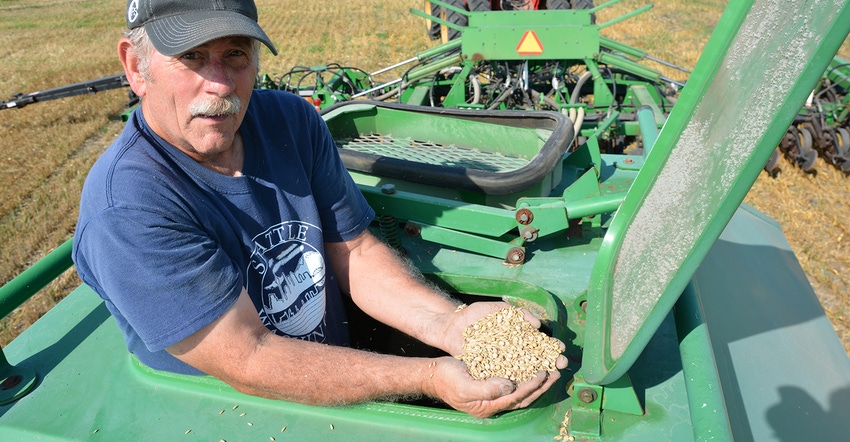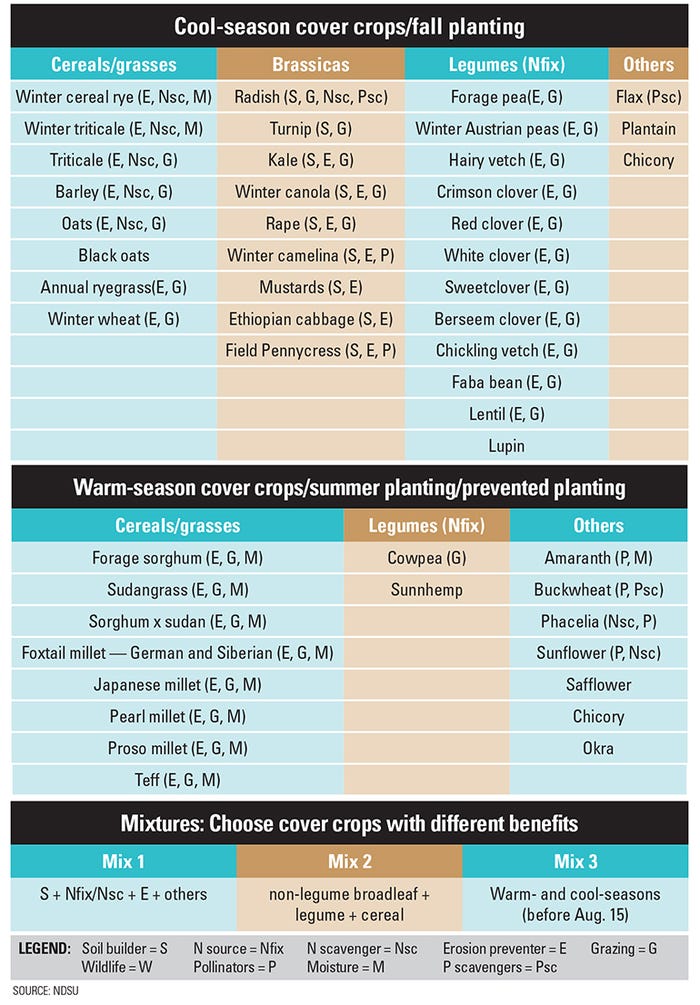
Curtis Knutson likes cocktails — cover crop cocktails, that is. Cover crop cocktails are mixtures of different plant species seeded together before or after a grain or oilseed crop to protect the soil.
Knutson, Page, N.D., doesn’t get too fancy with cover crop cocktails. He just uses two to four species, mostly a mix of legumes and grasses.
A mix of grass and broadleaf plants more consistently produces a good stand than a seeding of a single species, Knutson says. They canopy faster than a single species, which shades out weeds more effectively. A mixture also adds biodiversity to the fields, which helps recycle nutrients and feed soil micro-organisms.
Knutson’s ideas about cover crop cocktails are on track. “Each cover crop provides unique benefits to the soil,” says Ruth Beck, South Dakota State University Extension agronomist.
Good option this year
According to Sarah Bauder, SDSU Extension field agronomist, and Anthony Bly, SDSU soil health specialist, planting a cover crop on prevent plant acres this year is an especially good choice. Cover crops will:
1. Alleviate excess moisture. Cover crops will use up some of the excess moisture, compete with weeds and reduce the potential for increased salinity that can result in excess moisture in the soil profile.
2. Prevent phosphorus (P) deficiencies next year. Leaving land fallow reduces the population m fungi, which help facilitate P uptake by roots. A P deficiency can stunt growth and create uneven stands. “This is referred to as ‘fallow syndrome’ and it’s the result of reduced populations of mycorrhizal fungi in soils, which help to facilitate phosphorus uptake by roots,” Bly says. Lower populations of these fungi result from tillage and a lack of growing plants during the fallow period.
3. Protect the soil. Cover crops can help guard the soil from wind and water erosion and soil crusting.
4. Improve soil structure. Cover crops can strengthen soil structure, improving stability and reducing soil compaction issues.
5. Reduce soil carbon loss. Carbon is one of the main components of organic matter. The more organic matter the soil contains, the more productive it will be.
6. Produce additional forage. Currently, you can’t graze or harvest cover crop for feed until after Nov. 1, but there’s a bill in Congress to allow earlier use of cover crop on prevent plant acres.
Best choices
Which cover crops are the best to plant depends mostly on what you want them to do.

Herbicide carryover is a factor, too. Most herbicide labels do not list rotation restrictions for cover crops. But they will likely affect similar plants the same way. For example, any herbicide that has a long rotation interval requirement before field peas, will most likely also have a long rotation interval before lentils and other legumes. “This is a general rule of thumb,” Bauder says. “
When are you seeding? “If soils allow for planting by early to midsummer, warm season cover crops should be the primary plant type in the mix,” Beck says. “However, if you choose to plant after Aug. 10 (in the Dakotas), cool season crops should be the primary crop of choice as they thrive better in cooler fall temperatures.”
Forage options
Cover crop mixes can be used for forage. “They offer a unique opportunity to diversify risk from environmental conditions,” Beck says. “Combinations of different species can increase quality and yield of a forage crop, and offer greater potential for use for grazing, hay or silage.
Hay millets are best suited to be harvested as hay rather than grazed or cut for silage. “These plants have fine stems and, with the exception of teff grass, cures the easiest compared to other summer annuals. Hay millet can produce forage in as little as eight weeks after planting,” says Warren Rusche, SDSU Extension beef feedlot management associate.
Pearl millet offers more production potential than hay millets, Rusche says. Pearl millet has the ability to re-grow, making it a better option for grazing or for multiple cuttings at any growth stage. It has coarser stems than hay millet, making curing for baled hay more challenging. Unlike sudangrass, sorghum-sudangrass and forage sorghum, pearl millet doesn’t accumulate prussic acid, which means that cattle would not have to be temporarily removed due to an early frost.
Sudangrass and sorghum-sudangrass hybrids have thicker stems than most other forage crops and therefore are much better suited to be harvested as silage than hay. “They also work well as supplemental summer grazing,” Rusche says. “Prussic acid can be a concern when grazed. However, the greatest risk for prussic acid poisoning occurs when plants are damaged by frost, or when livestock graze short regrowth.”
To minimize risk, defer grazing until sudangrass is 18 to 20 inches tall and sorghum-sudangrass hybrids reach 24 to 30 inches. Remove livestock for five to six days if these plants are damaged by a killing frost so that the plants can dry out and the prussic acid can dissipate.
Forage sorghum is the latest maturing of the alternative forages and has the most production potential. Forage sorghum is best suited for silage. Prussic acid can also be a concern in forage sorghum.
Other popular forage options include an oat-pea mixture or other grass-legume mixes. The legumes provide protein to the mix at first cutting.
Specialists suggest choosing a main purpose for your intended cover crop and tailoring your mix to your rotation and herbicide history. Farm management is key.
Tip: Use the take-half-leave-half approach to protect soil health. Allow livestock to graze approximately 50% of the above ground plant matter before being moved to the next paddock or pasture.
“This allows the trampled or ungrazed portions of the field to provide cover, nutrient cycling and carbon for the field,” Bauder says.
More resources
If you have forage available, or are looking for grazing opportunities, visit the new South Dakota Grazing Exchange website.
To learn more about the best cover crops for your growing conditions and goals, visit bit.ly/sdcovercrops or contact SDSU Extension or your local Natural Resources Conservation Service office.
About the Author(s)
You May Also Like






